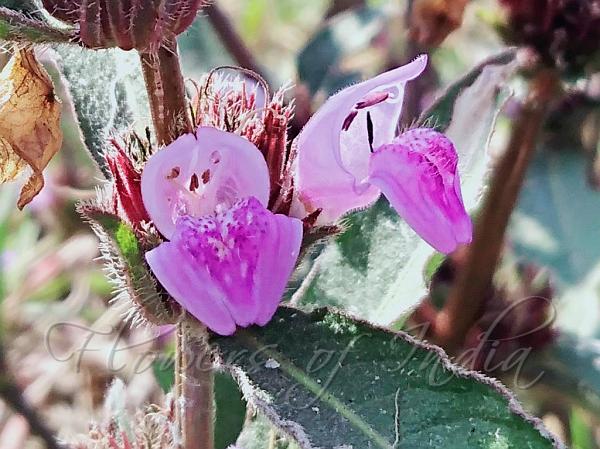|
| Sage Swampweed |
|

|

| File size | 261299 |
| Original date | 11/17/20 11:11 AM |
| Resolution | 4160 x 3120 |
| Flash | Flash did not fire, auto |
| Focal length | 3.47mm |
| Exposure time | 1/456s |
| Aperture | 2.2 |
| Focus Distance | |
| Metering Mode | Center weighted average |
| Camera make | OPPO |
| Camera model | OPPO A5 |
| Sensor type | OneChipColorArea |
|
|
|
|
Photo: |
Botanical name: Hygrophila phlomoides Family: Acanthaceae (Acanthus family)
Synonyms: Hygrophila obovata, Ruellia hirsuta, Ruellia phlomoides
Synonyms: Hygrophila obovata, Ruellia hirsuta, Ruellia phlomoides
Sage Swampweed is a perennial herb up to 1 m tall,
erect. Flowers are borne in leaf-axils, several clustered or in whorls
upward, like sage plants. Flowers are 1.8-2.2 cm, purplish,
velvet-hairy; lower lip oblong, sparely hairy, 3-lobed; upper lip
triangular, 2-lobed. Stamens are 4; longer pair about 5 mm, shorter
pair about 3 mm; Ovary hairless; style about 1.8 cm, velvet-hairy.
Bracteoles linear-oblong, about 5 x 2 mm, hairy. Sepal-cup is about 1.1
cm, white hairy, 5-lobed to middle; lobes linear. Stems are 4-angled,
brown bristly. Leaf-stalks are 0-3 mm, hairy; leaf blade elliptic,
obovate, or oblong, 2-9 x 1-3 cm, papery, both surfaces hairy,
secondary veins 8-15 on each side of midvein, base usually narrowed and
decurrent onto leaf-stalk, margin entire or wavy, tip pointed to
sometimes blunt. Sage Swampweed is found in wet places; below 1200 m,
in Eastern Himalaya, China and SE Asia.
Medicinal uses: Seeds are used for making
medicines to cure sore eyes, for flatulence, and for discoloration and
fungal infections of the skin. Crushed and used as a poultice over
festering and long-standing sores. In East and Southeast Asia,
primarily the leaves are used for poulticing fresh wounds, sprained
limbs, swellings, abscesses, boils, and headache.
Seeds are used for making
medicines to cure sore eyes, for flatulence, and for discoloration and
fungal infections of the skin. Crushed and used as a poultice over
festering and long-standing sores. In East and Southeast Asia,
primarily the leaves are used for poulticing fresh wounds, sprained
limbs, swellings, abscesses, boils, and headache.
Medicinal uses:
 Seeds are used for making
medicines to cure sore eyes, for flatulence, and for discoloration and
fungal infections of the skin. Crushed and used as a poultice over
festering and long-standing sores. In East and Southeast Asia,
primarily the leaves are used for poulticing fresh wounds, sprained
limbs, swellings, abscesses, boils, and headache.
Seeds are used for making
medicines to cure sore eyes, for flatulence, and for discoloration and
fungal infections of the skin. Crushed and used as a poultice over
festering and long-standing sores. In East and Southeast Asia,
primarily the leaves are used for poulticing fresh wounds, sprained
limbs, swellings, abscesses, boils, and headache. | Identification credit: Tabish | Photographed in Manipur. |
• Is this flower misidentified? If yes,